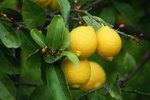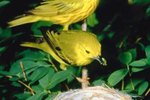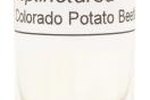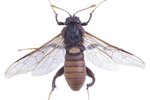
The expansive forest lands of Maine host the state's famous leaves worst enemy -- numerous species of insatiable, leaf-consuming caterpillars capable of defoliating enough acreage to make the results of their appetites visually unavoidable in the view scape. Each caterpillar species has its own tree species preference and feeding pattern at the photosynthetic buffet.
Birch Tree Caterpillars
The many species of birch trees in Maine provide an enticing meal for several caterpillar species. The smooth-skinned brown birch casebearer caterpillar feeds on the joints of new twigs and branches growing from brown birch trees. They create holes in the bark. The saddled prominent caterpillar featuring a brownish-colored body and prefers to eat the underside of the yellow birch leaf structures.
Oak Tree Caterpillars
Maine's oak trees are home to several caterpillar species whose feeding habits have been known to defoliate large stands of trees. The 25 different species of oakleaf caterpillars feed primarily on white oak tree leaves. A significant population explosion of oakleaf caterpillars between 1986 and 1988 defoliated more than 120,000 acres of hardwood forest in central and eastern Maine, according to the Maine Forest Service. The black gypsy moth caterpillar is extremely hairy, features red and orange banding on its body and also prefer the leaves of oak tree species.
Tenting Caterpillars
Tenting caterpillars are dubbed such based on their habit of building tentlike webs near a tree's trunk on branch intersections to deposit their eggs for winter protection. In the spring, as buds open on tree branches, the newly hatched young caterpillars feed on the buds. Maine has two tenting caterpillar species: the forest tent and the eastern tent. Forest tent caterpillars prefer oak, poplar, maple and birch trees. Eastern tent caterpillars feed on apple, crabapple and cherry trees.
Cottonwood, Poplar and Willow Caterpillars
The dense growths of cottonwood, poplar and willow tree stands in eastern and central Maine provide a buffet of leafy foliage readily consumed by the satin moth caterpillar. These small caterpillars spend the winter in cocoons and emerge in May to begin their feasting. Their bodies feature a grey or black background with yellow hair or white spots providing a contrast.
Stinging Caterpillars
Maine is home to a handful of caterpillars that aren't the fuzzy, soft-to-touch critters elementary-age children often keep in a jar to observe the cocooning process. These caterpillars have defensive stinging mechanisms such as venomous hairs, spines or horns capable of causing reactions in humans as mild as a burning sensation to as life-threatening as anaphylactic shock, according to the Maine School Integrated Pest Management Program. Species to avoid touching include the following: buck moth, puss or flannel moth, saddleback, slug, spiny oak and whitemarked tussock moth. Warning: These species feature bright colors and beautiful patterns making them attractive, but still potentially dangerous.
References
- Maine: Maine School IPM Program: Stinging Caterpillars
- Maine: Maine Forest Service: Tent Caterpillars
- Maine: Maine Forest Service: Variable Oakleaf Caterpillar
- Nature: Let's Explore: 10 Beautiful Yet Toxic Caterpillars
- The University of Maine: Home and Garden IPM From Cooperative Extension: Forest Tent Caterpillars
- Maine Nature News: Spiny Oak Slug
- The University of Maine: Fact Sheets: Forest and Eastern Tent Caterpillars
Photo Credits
-
Hemera Technologies/Photos.com/Getty Images
Writer Bio
Amy M. Armstrong is a former community news journalist with more than 15 years of experience writing features and covering school districts. She has received more than 40 awards for excellence in journalism and photography. She holds a Bachelor of Arts in communications from Washington State University. Armstrong grew up on a dairy farm in western Washington and wrote agricultural news while in college.




